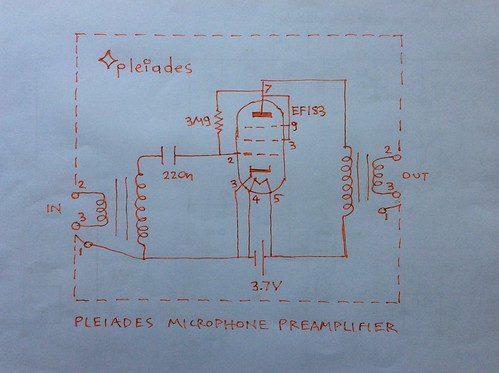It worked. Better than expected. Very nice and clear sound.
1.3V seems to provide great cathode underheating too on 2DV4, Neumann VF14 U47 way?
1.2V feeding a 2.1V specified heater may be similar to 3.6V feeding a 6.3V specified heater.
The 2DV4 was substituted on the Pleiades V6 booster mic amplifier schematic, with just 1.3V (always connect a suitable fuse in series with a battery for safety)

Cc is 22nF. The resitor used to reduce the negative bias on the grid is slightly less than (Red Magenta Green). A 1.2V rechargeable battery was connected to both heater and plate circuit. A fuse must always be used in series with a battery for safety.
The mic input transformer is the Altec Peerless 4722. The output transformer is the usual 10:1 used on all recent Pleiades experiments.
Signal path, setup:
male singing voice at 3in - Sennheiser MD441 U3 - Pleiades V6 with 1.2V at heaters and plate - Sony TC-D5 pro XLR mic input with phase inversion XLR adaptor and mono operation selected - Sennheiser HD580
The sound is very nice and clear with balance at all the frequency spectrum at about 3in from the MD441 U3.
The anode current must be ridiculously low, 1μA?, yet the electron tube operates and as a bonus the low anode current results in higher anode resistance reducing bass heaviness by interaction with the output transformer primary inductance. Another positive is that there is much less chance of the Nanoperm nanocrystaline Magnetec 070 core of the output transformer to saturate with such low anode DC current.
The MD441 U3 does not have a low cut filter. So if the anode current was higher bass heaviness would result or the mic should be used at a greater distance, say 12in.
A disadvantage is that it seems not to be the lowest noise booster amp tried. When a 0ohm link is connected to mic in or to left side of coupling capacitor hiss does decrease to about half the open circuit value or less. But a ticking clock at 30ft can be heard through headphones, ambience and increased gain hiss. On similar tests the hiss is much more decreased when anode current is about 30μA on experiments with higher plate supply voltage. Eg 3.6V, with EF183, 7586 Nuvistor etc.
The 2DV4 seems to operate better at 1.3V plate potential than the Nuvistor 7586. More tests are needed.
A good idea may be to increase anode supply of 2DV4 to 2.6V (using 2 AA batteries, 1 for heater, the 2 in series for plate). Or using a higher 9V or 12V plate supply and see if grid at space potential operation can be achieved. Suitable fuses should always be used in series with any battery for safety.
Further reading: The Pleiades Bias - euroelectron
D
No comments:
Post a Comment